Loading
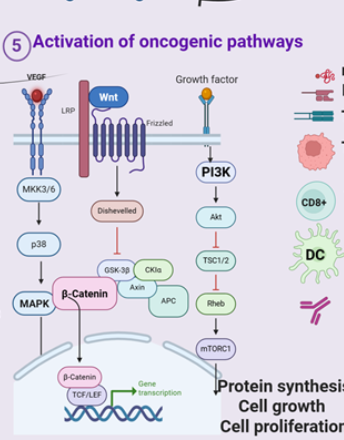
2025
Volume 7, Issue 4, p127-180
Articles published in this issue are Open Access and licensed under Creative Commons Attribution License (CC BY NC) where the readers can reuse, download, distribute the article in whole or part by mentioning proper credits to the authors.
Estrogen Receptor Alpha Contributes to Intestinal Inflammation in a Murine Model of Ileitis
Alyssia V. Broncano, Wendy A. Goodman
Inflammatory bowel diseases (IBD) are inflammatory conditions characterized by chronic and recurrent intestinal inflammation. IBD affects nearly five million people worldwide, with an estimated prevalence of 245.3 cases per 100,000 people in the United States alone. The incidence of IBD is steadily increasing in industrialized countries and is appearing more often developing countries, contributing to its rise as a global disease burden.
J Cell Immunol, 2025, Volume 7, Issue 4, p127-132 | DOI: 10.33696/immunology.7.232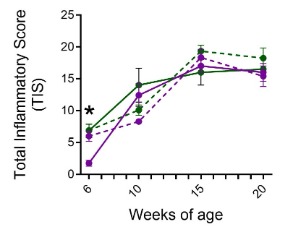
Salivary Lymphocyte Phenotypes Differ from Blood and Serve as a Model for Other Mucosal Fluids
Muruganantham Lillimary Eniya, Shervin Dokht Sadeghi Nasab, Albert Judith, Frederick Clasen, David Moyes, Saeed Shoaie, Newell Johnson, Priya Kannian, Stephen Challacombe
The oral cavity is part of the mucosal immune system of the body, embracing all mucosae including lungs, gut and nose. The oral mucosa is the gateway for a plethora of gastrointestinal and respiratory antigens and is capable of mounting a very strong mucosal immune response. Mucosal immunity is structurally and functionally similar in all mucosae and, soluble mediators including cytokines, chemokines, immunoglobulins and other proteins have been well studied in many diseases.
J Cell Immunol, 2025, Volume 7, Issue 4, p133-138 | DOI: 10.33696/immunology.7.233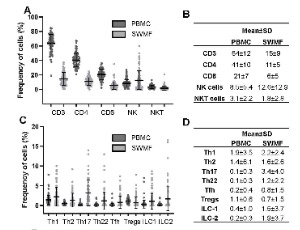
Serum Cytokines During Acute Respiratory Infection and Relationship to Age
Aanya Gupta, Holden T. Maecker
Influenza and other seasonal respiratory viruses affect millions annually. While age is generally known to be correlated with risk and outcome, the mechanisms underlying thesedifferences, especially in the infected, have been poorly defined. Previous studies have focused primarily on cell-subset shifts in older adults, leaving a gap in understanding of how cytokine responses vary across the full age spectrum.
J Cell Immunol, 2025, Volume 7, Issue 4, p139-145 | DOI: 10.33696/immunology.7.234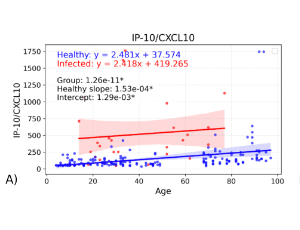
- Abstract |
- Full Text |
- Cite |
- Supplementary File
Mechanisms and Therapeutic Strategies to Overcome Immune Checkpoint Inhibitor Resistance in Melanoma, Head and Neck, and Triple-Negative Breast Cancers
Iryna Voloshyna, Apoorvi Tyagi, Stanzin Idga, Nicole Wang, Tazrif Amin, Madonna Hanna, Adil Mukhtar, Francesca Torres, Farah Kabir, Dominic Florian, Chloe Wang, Yury Patskovsky, Michelle Krogsgaard
Immunotherapy, particularly immune checkpoint inhibitors (ICIs), has revolutionized cancer treatment by harnessing the host immune system to target malignancies. Melanoma, head and neck squamous cell carcinoma (HNSCC), and triple-negative breast cancer (TNBC) were among the first solid tumors to gain regulatory approval for ICIs due to their immunogenicity and unmet clinical needs. Melanoma exemplifies the success of ICI therapy, with durable responses driven by its high mutation burden and neoantigen landscape, yet both primary and acquired resistance remain major challenges.
J Cell Immunol, 2025, Volume 7, Issue 4, p146-172 | DOI: 10.33696/immunology.7.235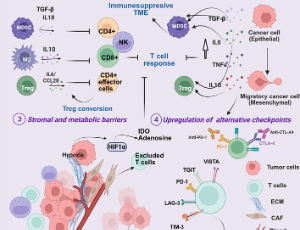
Risk Factors of Chronic Spontaneous Urticaria with COVID-19 Vaccination: A Cross-Sectional Study
Hossein Esmaeilzadeh, Mohammad Amin Gholami, Negar Mortazavi, Mohammad Reza Yousefi, Mohebat Vali
Chronic Spontaneous Urticaria (CSU) is a multifactorial disease with an incompletely understood etiology. COVID-19 vaccines can influence the immune system. This study evaluates the risk factors and comorbidities associated with CSU in patients who developed CSU following COVID-19 vaccination or infection.
J Cell Immunol, 2025, Volume 7, Issue 4, p173-180 | DOI: 10.33696/immunology.7.236
Recommended Articles
Deubiquitinase as Potential Targets for Cancer Immunotherapy
During the last few decades, immunotherapy is considered to be an important approach to help our immune system to fight various kinds of diseases, such as tumor. Sometimes, it works very well for some types of cancers, for example: bladder cancer, colorectal cancer, breast cancer and lymphoma.
The Endothelium: Global Integrator of Vascular-Immune Interactions
Endothelial cells (ECs) are mesodermally-derived modified simple squamous epithelial cells that collectively form the vascular endothelium–the vast living shield that lines the luminal surface of all blood vessels, the lymphatic circuit, and heart. Endothelial cell phenotypes vary among different organs and tissues with regard to specific barrier characteristics, and can be altered by environmental stimuli
Progression of Autoantibodies Anti-Gad and Anti-IA2 in Type 1A Diabetics Aged 5 to 21 Years in Cote d’Ivoire
Type 1A diabetes is an autoimmune disease, the final consequence of a slow and gradual process of ß-cell destruction of pancreatic islet Langerhans cells leading to ketoacidosis in the absence of treatment. This destruction of the β cells, responsible for the production of insulin, begins with the initiation of the autoimmune reaction triggered by certain environmental factors and, after several years of evolution, leads to the clinical signs of the disease when the mass of ß cells
Commentary on “Epigenetically Altered T Cells Contribute to Lupus Flares”
The recently published manuscript entitled “Epigenetically Altered T Cells Contribute to Lupus Flares” summarizes recent advances in our understanding of how the environment alters the immune system to cause flares of systemic lupus erythematosus (SLE) in genetically predisposed people, and why it affects women approximately 9 times more often than men
Design of a Peptide Against the Interaction Between Immune Response Protein TRAF5 and the Oncoprotein E6 from HPV
According to the World Health Organization (WHO), the human papillomavirus (HPV) affects more than 600 million people worldwide, being the most common sexually transmitted disease (STD). There were over 250,000 deaths due to cervical cancer worldwide and most of them took place in developing countries (WHO). There are more than 80 HPV types and more than 40 infect the genital tract
Proteomic Functional Signatures during the Priming of Human Th17 Cells
A combination of regulated responses toward pathogens and minimized autoimmune reactions is needed for the balanced function of the immune system. Amongst the immunologically important CD4+ lymphocytes, T helper 17 (Th17) cells help maintain homeostasis and provide protection against pathogens of fungal or bacterial origins
TNFAIP8: Inflammation, Immunity and Human Diseases
Inflammation can be caused by various environmental factors, including microbial infection and toxic chemical exposure. In response to inflammation, immune cells like macrophages, B and T lymphocytes, fibroblasts, endothelial cells, and various stromal cells secrete soluble polypeptide cytokine Tumor Necrosis Factor Alpha (TNF?)
The Role of NETosis in Systemic Lupus Erythematosus
Systemic Lupus Erythematosus (SLE) is a devastating autoimmune disease that affects women to men at a ratio of 9:1 and is predominant in those of African ancestry. In SLE, the presence of autoantigens results in aberrant immune activation leading to systemic inflammation that predominantly affects the brain, kidneys, blood, and skin. Current guidelines recommend treatment with immunosuppressive drugs like prednisone, cyclophosphamide, azathioprine, and even some antimalarial drugs
Dual Expression of GARP in Immune and Glioma Cells: Yet Another Mechanism of Cancer Immune Escape
Glioblastomas (GB) are amongst the most lethal human tumors exhibiting a highly aggressive behavior manifested by tumor cell infiltration into surrounding tissue. Furthermore, GBs are notorious for their high degree of resistance to cytotoxic treatments [1-3].
Targeting "Do Not Eat Me" Signal CD47 in Cancer Immunotherapy
Cells of the innate and adaptive arm of the immune system including macrophages, natural killer (NK) cells, neutrophils, T cells, and B cells, etc. are crucial for the maintenance of the body’s homeostatic balance and prevention of multiple diseases including cancer.
What Can Go Wrong When Applying Immune Modulation Therapies to Target Persistent Bacterial Infections
Antibiotics can treat the acute phase of a disease, but often do not completely clear the etiologic agent, allowing the pathogen to establish persistent infection that can revive the disease in a frustrating recurrence of infection. The mechanisms that control chronic bacterial infections are complex and involve pathogen adaptations that favor survival from both host immune responses and antibiotic bactericidal activity.
Is Platelet Desialylation a Novel Biomarker and Therapeutic Target in Immune Thrombocytopenia?
Immune thrombocytopenia is an autoimmune disease predominantly caused by autoantibody mediated platelet and megakaryocyte destruction and or dysfunction, which leads to low platelet counts and risk of bleeding. Currently prognostic biomarkers are underdeveloped and there lacks a gold-standard for therapeutics, which leaves an inexplicable refractory subset of patients which are clinically challenging.
A Novel Class of RIP1 or RIP3 Dual Inhibitors
Necroptosis is a form of programed necrosis mediated by receptor-interacting serine/threonine-protein kinase 1 (RIP1) and RIP3 and the subsequent phosphorylation of mixed lineage kinase domain-like protein (MLKL). Necroptosis has been implicated in multiple human diseases such as myocardial infarction, atherosclerosis, and abdominal aortic aneurysms (AAAs). Levels of RIP3 are elevated in the human tissues affected by these diseases.
Recent Advances Show That Abnormal T-Regulatory Cell Function Perpetuates Chronic Inflammatory Arthritis
The principal mechanism governing immune central tolerance is regulated by T-cells that reside in a pathway wherein the death of immature T-cells is coupled to the development of CD4+ regulatory T (Treg) cells. In that regard, Treg cells undergo development in the thymus or peripheral tissues upon recognition of self-antigens.
Tenofovir at the Crossroad of the Therapy and Prophylaxis of HIV and HBV Infections
Tenofovir, alias (R)-PMPA, was first divulged as an anti- HIV agent in 1993 [1]. That it would in 2012, become the first antiretroviral agent, approved by the US FDA (Food and Drug Administration) to prevent HIV infection, could have been predicted from the findings of Tsai et al.
CAR-T cell Goes on a Mathematical Model
CAR-T cell immunotherapy is a great advance in hematological cancers treatment. New CARs and therapy schemes are being developed and a mathematical model could contribute to a rational design of treatment. Here we comment and show new results with previously published models of CAR-T cell therapy, emphasizing the contribution of initial tumor load, the proliferation of CAR-T cell and inhibition of CAR-T cell activity by the tumor resulting in different scenarios as tumor escape, equilibrium (stable disease) and tumor elimination.
A New Window onto the Pacemaker of the Heart, the Sinus Node, Provided by Quantitative Proteomics and Single- Nucleus Transcriptomics
Hypothesis-driven research has dominated biomedical science for at least the past century. There are many papers and grant applications that will have been rejected because they are not hypothesis-driven. For example, Haufe reports that the NIH guidelines for RO1 grants states that “A strong grant application is driven by a strong, solid hypothesis with clear research objectives”.
Naltrexone as a Novel Therapeutic for Diabetic Corneal Complications
Diabetes is a widespread autoimmune disorder that affects nearly 10% of the adult population in the United States. In addition to the primary disease, there are numerous complications associated with inflammation including abnormalities of the heart, visual system, and peripheral nervous system. More than half of the individuals with diabetes will have one or more ocular related complications such as dry eye disease (DED), keratopathy, or retinopathy.
Autism – A Potential Autoimmune Disease Neurodegeneration-Induced Autoantibodies against Neural Proteins
We hypothesize that maternal neurodegeneration, resulting from a chemical, infectious or physical brain injury event, can be causative in the development of autism spectrum disorders (ASD). Following a maternal brain injury event before or during gestation, maternal neural proteins escape the breached blood brain barrier (BBB), triggering the formation of IgG autoantibodies.
Multiple Roles of the Interleukin IL-17 Members in Breast Cancer and Beyond
Interleukin-17 (IL-17) family proteins are involved in the control of infections. When unrestrained, these cytokines contribute to the development of chronic inflammatory diseases. The IL-17 family contains 6 members: IL-17A to F. In this review, we outline the current knowledge on the roles of each IL-17 member on breast cancer.
